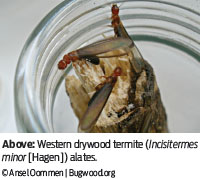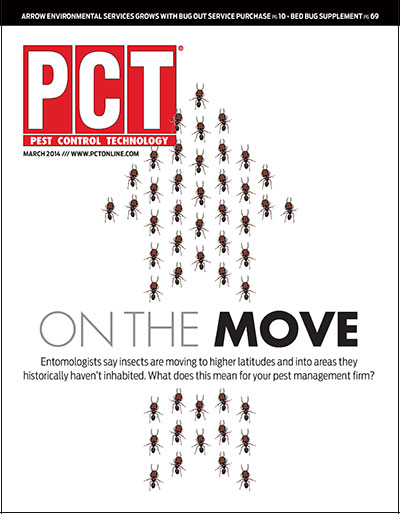 Of the 28 species of invasive termites recently listed in a new report, seven (25 percent) are drywood termites (Evans et al. 2013). This report also mentioned that termites’ global importance will increase due to intensified trade and the ability to form small propagules of individuals that ease transport to distant locations. Only species in the family Rhinotermitidae (subterranean termites, especially in the genus Coptotermes) have a higher potential for invasive spread around the world (Evans et al. 2013). One particular species, the western drywood termite, Incisitermes minor (Hagen), is native to the Western United States and already has spread to the Eastern United States, Eastern Canada, the Hawaiian Islands and parts of Asia (Evans et al. 2013). The additional spread of drywood termite species via commerce is predicted.
Of the 28 species of invasive termites recently listed in a new report, seven (25 percent) are drywood termites (Evans et al. 2013). This report also mentioned that termites’ global importance will increase due to intensified trade and the ability to form small propagules of individuals that ease transport to distant locations. Only species in the family Rhinotermitidae (subterranean termites, especially in the genus Coptotermes) have a higher potential for invasive spread around the world (Evans et al. 2013). One particular species, the western drywood termite, Incisitermes minor (Hagen), is native to the Western United States and already has spread to the Eastern United States, Eastern Canada, the Hawaiian Islands and parts of Asia (Evans et al. 2013). The additional spread of drywood termite species via commerce is predicted.
History of Drywood Control.
The control of drywood termites is typically classified as remedial or preventive. Remedial efforts are intended to kill termites present at the time of application, while preventive procedures are intended to stop or prevent infestation, i.e., initial colony formation. Local treatment is the most common and oldest known remedial control method for drywood termites and is also generally restricted to a single or small group of boards or locations within boards. Estimates on the proportion of local treatments conducted each year is difficult to ascertain, however in California at least 70 percent of all reported drywood termite control methods involve local applications of pesticides (Lewis 2003).
Today, there are 53 active ingredients formulated into 354 commercial products listed in the Environmental Protection Agency database and these vary between states. During the early 19th century, subsurface injections employing the drill-and-treat method using dust formulations of Paris green (sodium flusilicate) and calcium arsenic (Kali-dust) were the mainstay of drywood termite control efforts (Lewis and Forschler 2014).
Currently, there are six active ingredients that dominate most markets. They are applied as liquid or foam and until recently only one was labeled for use as a dust (Lewis et al. 2009).
Local treatments require drilling holes into the infested wood member and the number of drilled holes is variable among labels and industry practice. Recent university papers report diamond patterns of holes drilled at regular increments along the entire length of the infestation or board (Lewis et al. 2009; Rust and Venturina 2009). Drilling the fewest holes to treat drywood termite infestations would realize a savings in time to companies, damage to structures and reduce safey risks (e.g. minimizing pesticide exposure and treatments requiring a ladder) to PMPs.
Industry and research communities are constantly searching and testing for new active ingredients, formulations and techniques. When our lab learned about BASF Corporation developing a new drywod formulation of Termidor, we wanted to test it and its potential using a single injection hole per infestation. BASF Corporation provided us with the specially designed applicator, Termidor Dry and blank microcrystalline cellulose matrix for a control.

Remedial Control.
We secured firewood-sized loquat logs infested with drywood termites (Fig. 1a). After verifying the infestations were active using X-ray images and a termite feeding detection device (Tracker, Dunegan Engineering, Midland, Texas), we drilled a single hole at a 45-degree angle in each log and then injected 3 to 5 bulb compressions (0.1 g/injection) of either Termidor Dry (0.5 percent fipronil) or cellulose matrix. We also consulted the X-ray images to aid in determining the best locations and depths of treatment holes.
We monitored termite feeding activity for all logs continuously three days pre-treatment and for two months post-treatment in a sealed incubator maintained at 70 degrees F using a computerizied, multi-channel monitoring device (AE Smart system, Dunegan Engineering, Midland, Texas) (Fig. 1a).
Figures 1b and c shows the trace of feeding activity for a treated and control log. Within three days after treatment, termite feeding in all logs treated with Termidor Dry dropped to zero. However, for the control log, feeding continued at a high rate of more than 2,000 feeding events per minute for the following two months.
Preventive Control.
Two years after the remedial performance tests, we conducted a test on preventive performance of Termidor Dry. For simulated re-infestations, we inserted a live drywood termite colony into the same three logs that were previously treated and into three untreated logs that were inactive for termites. Only robust colonies that had more than 150 healthy workers and at least one soldier were used. Termites were poured down a funnnel through a 3/4-inch diameter hole drilled into the midsection of each log and later plugged with a cork (Fig. 2a). Once all logs were re-infested, they were continuously monitored for two weeks in the same manner as for remedial tests.
Post-treatment results were very similar to those from the remedial tests (Figs. 1b and c) and can be characterized as termite feeding activity plummeting for treated logs within three days while feeding activity remained high for control logs. Two weeks later searches with the microwave device (Termatrac T3i, Termatrac, Australia Pty, Ltd.) confirmed termite movement in control logs and no movement in treated logs (Fig. 2b, bottom and top images). The corks were then removed and logs were tapped over a clean tray. Congruent with other results, live termites were easily seen in untreated logs and only dead termites were found in treated logs (Fig. 2c, top and bottom images).
Final Thoughts.
Combining results from both tests reveal a high level of performance of Termidor Dry used for remedial and preventive control of drywood termites. However, real-world field results may vary based on initial inspection, and use of monitoring devices to access the extent and accessibility of an infestation.
Also highly variable for local treatments is the degree of voided fecal pellets clogging gallery systems and chambers that may impair the flow of pesticides. Our lab recommends consumers contact their local pest management experts when confronted with drywood termite questions for a thorough inspection, price quote, and information about the effectiveness of a local treatment compared to other whole-structural treatment options.
Author’s Acknowledgements: The authors wish to thank Dr. James Baldwin with the USDA Forest Service, Pacific Southwest Research Station, Albany, Calif., for statistical consulting and providing figures. We would also like to thank our laboratory staff, Thomas Siu and Tyler Yan, for extracting drywood termite colonies for the preventative trial. Partial funding for this research was provided by the BASF Corporation. Photographs taken by Robin Tabuchi, UC Berkeley.
The authors are with the Urban Pest Management Center at the UC Berkeley Richmond Field Station, Richmond, Calif.
References
Evans, T.A., Forschler, B.T. and Grace, J.K. 2013. Biology of invasive termites: a worldwide review. Annual Review of Entomology 58, 455-474.
Lewis, V.R. 2003. IPM for drywood termites (Isoptera: Kalotermitidae). J. Entomol. Sci. 38: 181-199.
Lewis, V.R., Moore, S., Tabuchi, R. and Getty, G. 2009. Field evaluations of localized treatments for the control of drywood termite infestations in California. Final Report to the California Structural Pest Control Board, Sacramento, CA, USA, pp. 1-28. Also available at http://www.pestboard.ca.gov/howdoi/research/2009_field_rpt.pdf.
Rust, M.K. and Venturina, J. 2009. Evaluation of chemical localized treatment for drywood termite control, Final Report to the California Structural Pest Control Board, Sacramento, CA, USA, pp. 1-31. Also available at http://www.pestboard.ca.gov/howdoi/research/2009_drywood_rpt.pdf.
Lewis, V., and B. Forschler 2014. Management of Drywood Termites: Past practices, present situation, and future prospects In: Dhang, P. (ed.) Urban Insect Pest : Sustainable Management Strategies CABI. London (in press).

Explore the March 2014 Issue
Check out more from this issue and find your next story to read.
Latest from Pest Control Technology
- SiteOne Hosts 2024 Women in Green Industry Conference
- Veseris Celebrates Grand Reopening of the Miami ProCenter
- Rollins' 2024 Second Quarters Revenues up 8.7 Percent YOY
- Fleetio Go Fleet Maintenance App Now Available in Spanish
- German Cockroach Control Mythbusting
- Total Pest Control Acquires Target Pest Control
- NPMA Workforce Development Shares Hiring Updates
- Certus Acquires Jarrod's Pest Control





